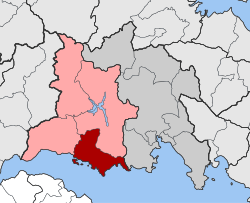Tolofon
|
Tolofon Τολοφών |
|
|---|---|
| Coordinates: 38°22′N 22°12′E / 38.367°N 22.200°ECoordinates: 38°22′N 22°12′E / 38.367°N 22.200°E | |
| Country | Greece |
| Administrative region | Central Greece |
| Regional unit | Phocis |
| Municipality | Dorida |
| • Municipal unit | 131.38 km2 (50.73 sq mi) |
| Population (2011) | |
| • Municipal unit | 2,762 |
| • Municipal unit density | 21/km2 (54/sq mi) |
| Community | |
| • Population | 539 (2011) |
| Time zone | EET (UTC+2) |
| • Summer (DST) | EEST (UTC+3) |
| Vehicle registration | ΑΜ |
| Website | www.fokida.gr/en/dim_tolofonas.html |
Tolofon (Greek: Τολοφών, also Τολοφώνας, before 1927: Βιτρινίτσα - Vitrinitsa) is a village and a former municipality in Phocis, Greece. Since the 2011 local government reform it is part of the municipality Dorida, of which it is a municipal unit. The municipal unit has an area of 131.384 km2. In 2011 its population was 2,762. The seat of the municipality was in Erateini. The ancient site of Tolophon is located in the northeastern part of the municipal unit. It is situated on the mountainous north coast of the Gulf of Corinth.
The region of Tolofon along with the valley of Erateini were relatively densely populated in the prehistoric and early historic periods according, at least, to the archaeological finds. Architectural remains and burial traces dated to the Middle Helladic period have been excavated on the beach of Tolofon and around the rupestral church of St. Paraskevi. At the site of Mathiou (or Marathiou) there are some visible remains of a Cyclopean fortification, typical of the Mycenaean era, and some fortifications at the sites Bouhouri and Palaiokastro of Vitrinitsa are also extant. A Mycenaean settlement must have existed on the Pitha hill, as attested by the Mycenaean pottery and sherds discovered on the spot. The same hill was inhabited also in later periods, as attested by the fortifications of the Classical and Hellenistic periods. Scholars identify the site as ancient Oeantheia, one of the main cities of western Locris, but there is no secure testimony to that identification. However, one has to admit that large part of the building material of the site has been reused, for example at the medieval tower on the foothill of Pitha and at the Church of the Evangelistria (Panagia Polyportou), a Byzantine church of the 10th-11th century A.D. Finally, at Marathias close to Erateini a burial within a pithos (large jar) dated to the 7th century B.C. revealed a large number of Corinthian vessels, particularly aryballoi, as well as a scarab made of fayence, on display now at the Archaeological Museum of Amfissa. These finds attest to the commercial relations between the two shores of the Corinthian Gulf.
...
Wikipedia


